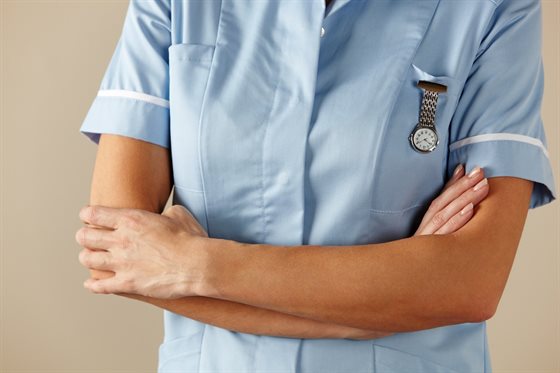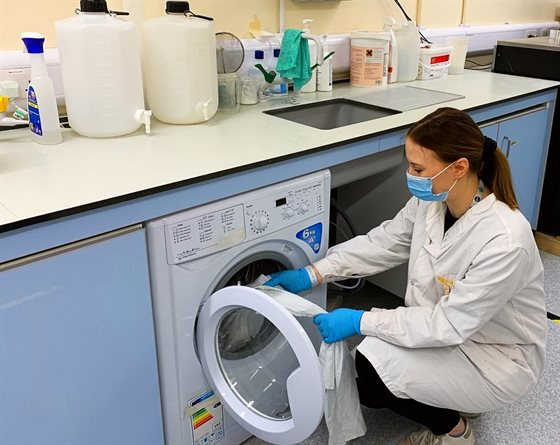A lack of adequate changing facilities at hospitals in England is preventing healthcare workers from safely washing their uniforms in accordance with NHS guidance, a new study has found.
Professor Katie Laird and Dr Lucy Owen, from Infectious Disease Research Group at De Montfort University Leicester (DMU), surveyed more than 1,200 nurses, healthcare workers and nursing students across England, to learn about their behaviours and attitudes towards laundering of their uniforms during the Covid-19 pandemic.

Image: Shutterstock
Results from the nationwide study show that more than a fifth of respondents deviate from the NHS uniform guidelines and that onsite changing facilities are the most significant barrier, and that more than two thirds of respondents would prefer their employer to wash their uniforms.
Comments by healthcare workers suggest that there is a lack of changing areas in some hospitals, while in those that do offer designated areas, there are concerns over cleanliness, space and provision of showers.
“If nurses are not provided with appropriate facilities to change on site, they are forced to wear their uniforms in domestic environments, such as their car or at home,” said Professor Laird, expert microbiologist and lead researcher on the project.
“This creates an infection control risk, with the potential transfer of microorganisms such as coronavirus and other hospital acquired infection – particularly those caused by bacteria such as MRSA – from healthcare uniforms onto surfaces.”
The current NHS guidance for uniforms and workwear, which was last updated in November 2021, states that:
“Where an employee has to wear special clothing (for example, a uniform) for the purposes of work, then suitable and sufficient changing facilities are to be made available to them along with secure facilities to store personal clothing. Where work is strenuous, dirty or could result in contamination, showers must be provided.”
Professor Laird continued: “To minimise the risk of transmission, it is vital that the guidelines are followed and uniforms are removed before healthcare workers travel home. If they have to take their uniforms home and launder them, it is crucial that textiles are washed at the recommended temperature and for the recommended amount of time, to ensure the removal of microorganisms.”
For effective infection control in a domestic setting, where washing machines do not always reach the temperature stated, Professor Laird recommends that uniforms be washed at either 71⁰C for a minimum of three minutes, or 60⁰C for at least 10 minutes. Detergents and disinfectants also need to be applied to the laundry process at home.
Other findings from DMU’s survey show that:
-
A proportion of healthcare workers (17%) failed to launder at the recommended temperature of 60°C at home.
-
A limited number of healthcare workers (12%) are being offered industrially laundered scrubs in place of their uniform in response to the COVID-19 pandemic, with most continuing to wear their normal uniform (87%).
This research follows a previous study led by Professor Laird last year, which found viruses similar to the strain that causes Covid-19 can survive on clothing and transmit to other surfaces for up to 72 hours.

Image: Dr Owen examining the survival of viruses similar to Covid-19 on textiles
“Our findings from the initial study showed that three of the most commonly used textiles in healthcare – cotton, polyester and polycotton – pose a risk for transmission of the virus,” explained Professor Laird.
“We therefore know that if nurses and healthcare workers take their uniforms home, they could be leaving traces of the virus on other surfaces.”
At the height of the pandemic in 2020, Public Health England (PHE) published guidance stating that industrial laundering should be used for healthcare worker uniforms but where it is not possible, staff should take uniforms home to be laundered.
However, after discovering the virus could survive up to three days and transmit to other surfaces, Professor Laird advised the government that all healthcare uniforms should be laundered in hospitals to commercial standards or by an industrial laundry.
“This latest survey further reinforces the need for in-house or industrial laundering of healthcare uniforms,” added Professor Laird. “It is clear to see that nurses, healthcare workers and nursing students are not able to adhere to recommended guidelines due to a lack of facilities and that they would prefer their employer to offer professional laundering.”
Professor Laird and Dr Owen worked alongside DMU’s Lindsay Apps, a practitioner health psychologist, and University Hospital Leicester (UHL)’s Dr Andrew Hall, who is a consultant in Anaesthesia and Intensive Care Medicine at Leicester General Hospital and active researcher at the University of Leicester, on this study.
“A better understanding of healthcare workers’ barriers, concerns and preferences is important when considering what will better support change in this practice,” said Ms Apps. “This study will help to identify where personal and organisational factors are influential to better inform safer practices and lead to recommendations for how services can support their healthcare workers more effectively.”
Dr Hall added: “This research is important because it highlights a national problem. The Covid-19 pandemic has acutely exposed the poor provision of staff changing areas and the steady erosion of in-house laundry services for uniformed staff, many of whom are expected to change in crowded toilet areas with limited provision of shower facilities and lockers for clothes and personal belongings. In relation to infection control, this increases the risks not only to patients but also to staff and their families.”
Posted on Thursday 3 February 2022